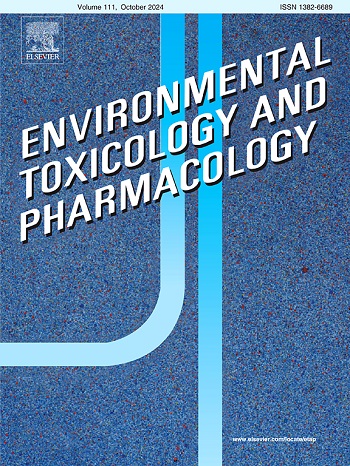独居蜜蜂对农用化学品的易感性突出了蜜蜂风险评估的空白。
IF 4.2
3区 环境科学与生态学
Q2 ENVIRONMENTAL SCIENCES
引用次数: 0
摘要
地面筑巢的独居蜜蜂是世界干旱地区数量最多的蜜蜂种类,但农药对它们的影响研究甚少。在此,我们评估了一种杀虫剂、一种除草剂和一种精油对地中海地面筑巢蜜蜂(Andrena impunctata, Andrena nigroolivacea, Andrena stabiana, Andrena vetula)以及管理的蜜蜂(Apis mellifera, Bombus terrestris, Osmia bicornis)的局部毒性。我们测试了商业配方的醋氨虫、草甘膦和一种基于甜橙精油的生物杀虫剂的致死效果,并评估了受管理的蜜蜂在相同处理下的运动行为。尽管野生蜜蜂实验前条件的潜在差异可能影响了易感性,但根据体重、体长和蝶间距离的测量,较小的蜜蜂比较大的蜜蜂更容易受到农用化学品的影响。对大多数被试物种来说,醋氨脒是毒性最大的化合物。处理过的蜜蜂也表现出对乙酰虫脒暴露后的神经元症状,以及不同物种和农用化学品的运动改变。我们的研究结果显示了蜜蜂的易感性在不同物种之间是如何与它们的体型相关的,突出了在当前蜜蜂风险评估中需要额外的模型物种。本文章由计算机程序翻译,如有差异,请以英文原文为准。

Susceptibility of solitary bees to agrochemicals highlights gaps in bee risk assessment
Ground-nesting solitary bees are the most abundant bee species in the xeric areas of the world, but the effects of agrochemicals on them have been little studied. Herein, we evaluated the topical toxicity of an insecticide, a herbicide, and an essential oil on Mediterranean ground-nesting bees (Andrena impunctata, A. nigroolivacea, A. stabiana, and A. vetula), and on the managed Apis mellifera, Bombus terrestris, and Osmia bicornis. We tested the lethal effects of commercial formulations of acetamiprid, glyphosate and a biopesticide based on sweet orange essential oil, and evaluated the locomotor behaviours of managed bees exposed to the same treatments. Although potential differences in pre-experimental conditions of wild bees may have influenced susceptibility, smaller bees, based on the measurements of weight, body length, and inter-tegular distance, were more susceptible to agrochemicals than the larger ones. For the majority of the tested species, acetamiprid was the most toxic compound. Treated bees also showed neuronal symptoms after acetamiprid exposure and locomotor alterations that varied among species and agrochemicals. Our results show how the susceptibility of bees varies between species in relation to their body size, highlighting the need for additional model species in current bee risk assessments.
求助全文
通过发布文献求助,成功后即可免费获取论文全文。
去求助
来源期刊
CiteScore
7.00
自引率
4.70%
发文量
185
审稿时长
34 days
期刊介绍:
Environmental Toxicology and Pharmacology publishes the results of studies concerning toxic and pharmacological effects of (human and veterinary) drugs and of environmental contaminants in animals and man.
Areas of special interest are: molecular mechanisms of toxicity, biotransformation and toxicokinetics (including toxicokinetic modelling), molecular, biochemical and physiological mechanisms explaining differences in sensitivity between species and individuals, the characterisation of pathophysiological models and mechanisms involved in the development of effects and the identification of biological markers that can be used to study exposure and effects in man and animals.
In addition to full length papers, short communications, full-length reviews and mini-reviews, Environmental Toxicology and Pharmacology will publish in depth assessments of special problem areas. The latter publications may exceed the length of a full length paper three to fourfold. A basic requirement is that the assessments are made under the auspices of international groups of leading experts in the fields concerned. The information examined may either consist of data that were already published, or of new data that were obtained within the framework of collaborative research programmes. Provision is also made for the acceptance of minireviews on (classes of) compounds, toxicities or mechanisms, debating recent advances in rapidly developing fields that fall within the scope of the journal.

 求助内容:
求助内容: 应助结果提醒方式:
应助结果提醒方式:


